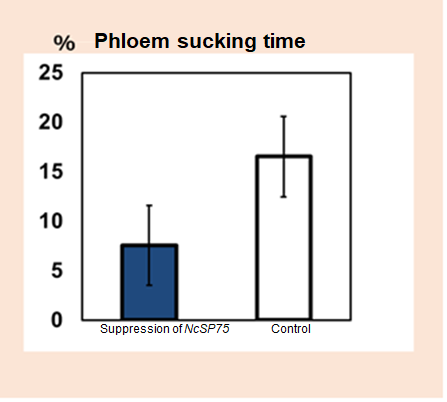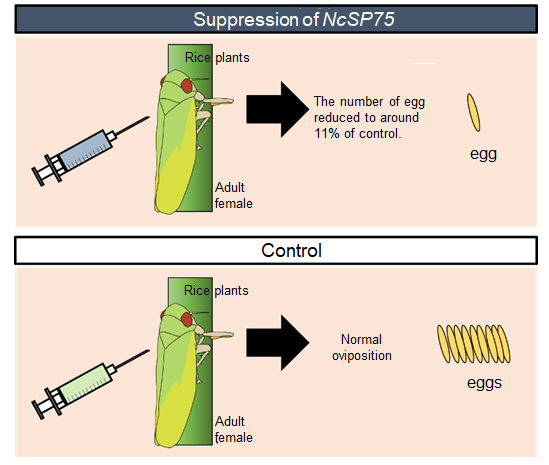The Institute of Agrobiological Sciences, NARO (NIAS) has discovered that the salivary protein NcSP75 is essential for feeding from phloem sap in green rice leafhopper (Nephotettix cincticeps). Suppression of the expression of this gene induces inhibition of sucking from phloem, resulting in growth retardation of nymphs, and decreasing the number of eggs laid by the female. This protein could be used as a potential target in developing a biologically efficient technology to protect rice plants from the pest damage.
Overview
The green rice leafhopper has a needle-like mouth and sucks nutrient-rich phloem sap from rice plants. It damages the rice plants by sucking sap and by transmitting virus and phytoplasma diseases, thus causing crop yield loss.
The Institute of Agrobiological Sciences, NARO (NIAS) has comprehensively analyzed the proteins expressed in saliva and found a protein essential for sucking sap of rice plants. When the expression of the NcSP75 gene is suppressed, the green rice leafhopper could not easily suck phloem sap from rice plants. Suppression of NcSP75 delayed growth and reduced survival rate in nymphs. Most of the nymphs die before reaching adult stage. In adult female, suppression of NcSP75 reduced the number of deposited eggs to one-ninth as compared to control. Meanwhile reduction was not observed in survival rate of NcSP75 suppressed insects fed on artificial diet. These results suggest that NcSP75 protein should be necessary for sucking sap of rice plants.
The NcSP75 protein is specific to green rice leafhopper so far. Therefore, NcSP75 may be a promising target to control the pest.
Publications
- Matsumoto Y & Hattori M (2018) The green rice leafhopper, Nephotettix cincticeps (Hemiptera: Cicadellidae), salivary protein NcSP75 is a key effector for successful phloem ingestion. PLOS ONE 13, e0202492.
- Hattori M, Komatsu S, Noda H, Matsumoto Y (2015) Proteome analysis of watery saliva secreted by green rice leafhopper, Nephotettix cincticeps. PLOS ONE 10, e0123671.
- Matsumoto Y, Suetsugu Y, Nakamura M, Hattori M (2014) Transcriptome analysis of the salivary glands of Nephotettix cincticeps (Uhler). Journal of Insect Physiology 71, 170-176.
For Inquiries
Contact: http://www.naro.go.jp/english/inquiry/index.html
Reference Information

Fig. 1. Green rice leafhopper (adult female) sucking rice sap
The body length is about 5-7 mm. After hatching, it emerges into the 1-5 instar nymph. The female lays 100-200 eggs inside the rice plants.

Fig. 2. Suppression of NcSP75 Inhibits phloem sucking
By suppressing the expression of the NcSP75 gene, phloem sucking time is shortened to less than half of the control. The suppression of the NcSP75 gene is shown to inhibit phloem sucking.

Fig. 3. Suppression of NcSP75 gene delayed growth and reduces survival rate
Suppression of NcSP75 gene in third instar larval stage delayed growth rate and decreased the survival rate of green rice planthopper. Most of insects died before reaching adult stage.

Fig. 4. Suppression of NcSP75 gene reduces number of laid eggs
After the suppression of the NcSP75 gene, more than 40% of the female adults laid no eggs, and the number of eggs decreased to 10.8% compared to control.

Fig. 5. NcSP75 gene is essential for sucking rice sap
Suppression of NcSP75 decreased survival rate of green rice leafhopper reared on rice plants (upper). The effect of suppression of NcSP75 was not detected when fed with artificial diet (bottom). Therefore, NcSP75 is considered to be an essential gene for sucking sap.




